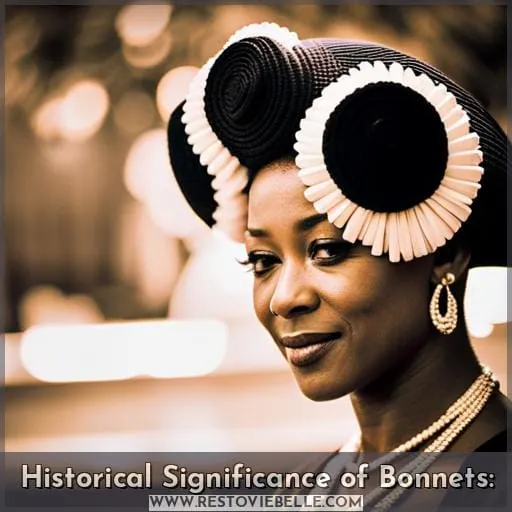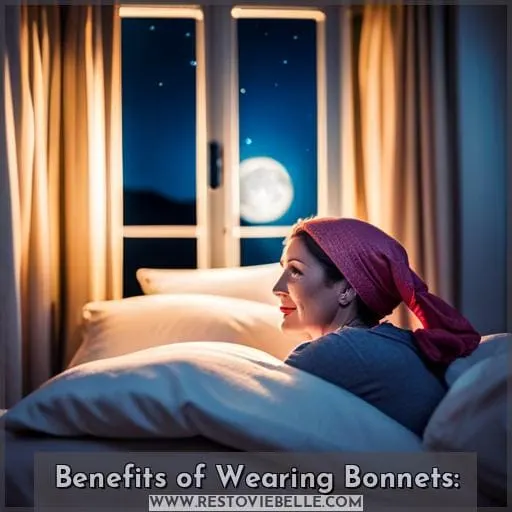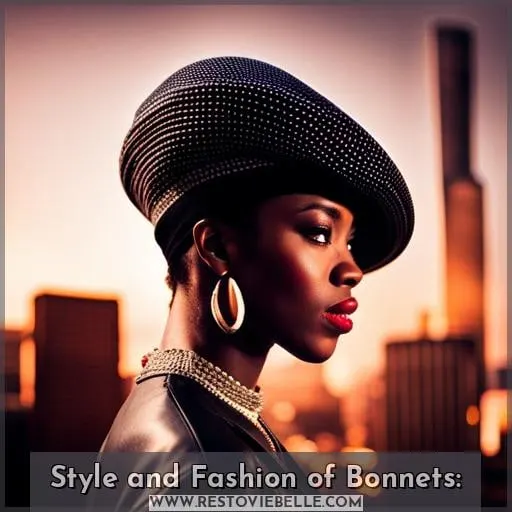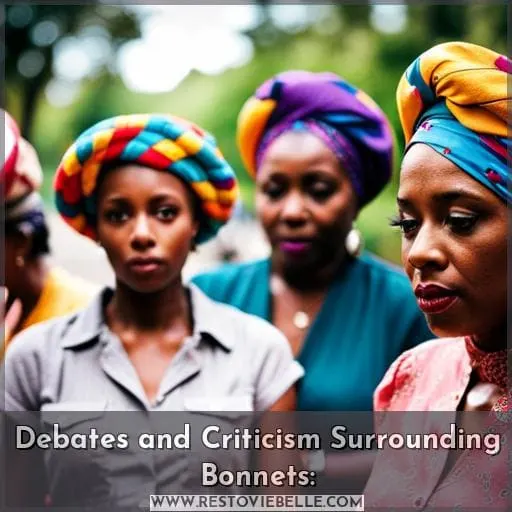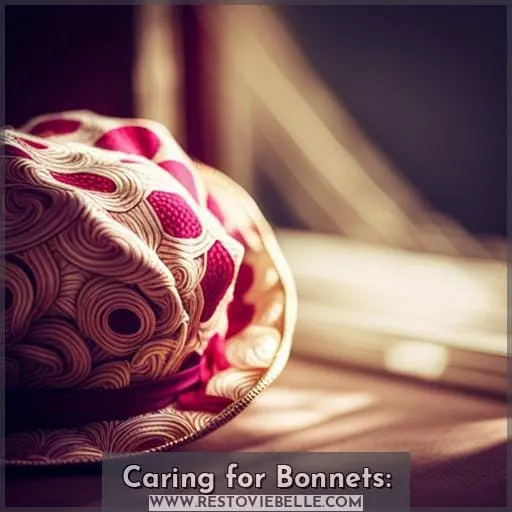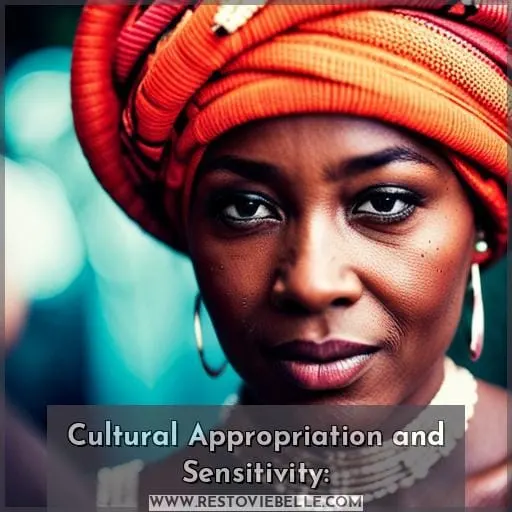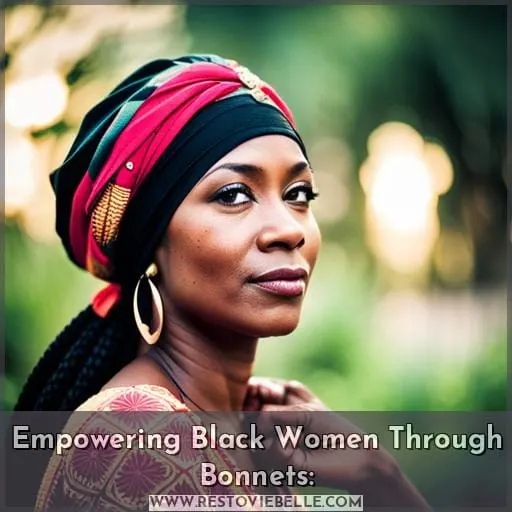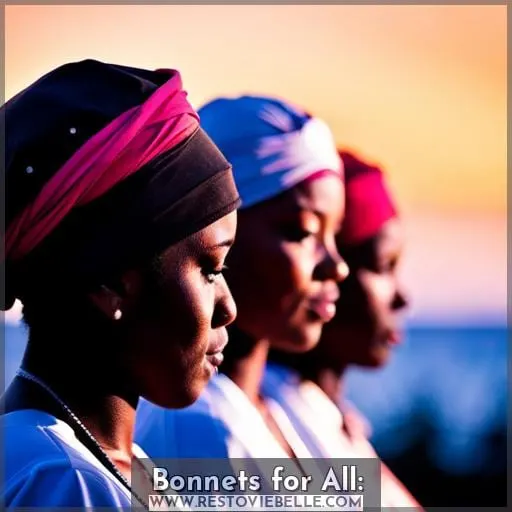This site is supported by our readers. We may earn a commission, at no cost to you, if you purchase through links.
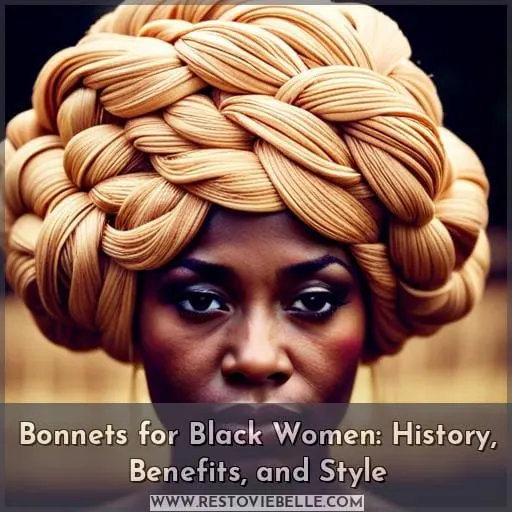 Picture this:
Picture this:
You, wrapped in a soft satin bonnet, feeling empowered and confident as you embrace the history, benefits, and style of bonnets for Black women.
From protecting your hair’s health to honoring cultural significance and identity, these stylish accessories offer more than meets the eye.
Join us on a journey through time as we explore the impact of bonnets on Black women everywhere.
Get ready to discover why these fashionable headgear choices are so much more than just an accessory for your hair – they’re a symbol of liberation and belonging.
Table Of Contents
- Key Takeaways
- Historical Significance of Bonnets:
- Benefits of Wearing Bonnets:
- Style and Fashion of Bonnets:
- Debates and Criticism Surrounding Bonnets:
- Where to Buy Bonnets:
- Caring for Bonnets:
- Cultural Appropriation and Sensitivity:
- Empowering Black Women Through Bonnets:
- Bonnets for All:
- Frequently Asked Questions (FAQs)
- Are bonnets only worn by Black women?
- How do bonnets protect different hairstyles?
- What are some alternative options to bonnets for hair protection?
- How does the debate about bonnets relate to larger discussions of cultural appropriation?
- Are there any specific cultural considerations when wearing bonnets outside of the United States?
- Conclusion
Key Takeaways
- Bonnets have a deep historical and cultural significance in African regions, symbolizing identity assertion, resilience, and resistance against colonial influence.
- Wearing bonnets provides numerous benefits for black women’s hair, including protection from tangling, frizz, and breakage, as well as moisture retention and maintenance of hairstyle integrity during sleep.
- Bonnets and headwraps serve as powerful tools for cultural expression and communication of personal identity, allowing black women to assert ownership over their appearance and narratives surrounding blackness.
- Embracing bonnets as acts of self-care rooted in cultural traditions challenges societal norms, promotes inclusivity, and encourages respectful understanding and acceptance of diverse hair types and styles.
Historical Significance of Bonnets:
When exploring the historical significance of bonnets for Black women, it’s important to understand their origins and evolution as a form of protection and cultural expression.
Bonnets have undergone a cultural evolution over time, with deep societal impact. In African regions like Ghana and Namibia, headwraps were traditional attire that served as symbolic expressions of identity assertion.
During enslavement in America, bonnets were used by white oppressors to visually distinguish Black women as inferior or subhuman. However, in parts of Central America, Black women covertly communicated coded messages through the folds in their headscarves that only they could understand.
Thus, bonnets hold immense historical and cultural significance beyond being protective hair coverings; they represent resilience amidst colonial influence while serving as vehicles for coded messages within African communities.
Benefits of Wearing Bonnets:
Wearing bonnets provides several benefits for Black women.
Firstly, they help protect the hair from tangling, frizzing, and drying out, promoting overall hair health.
Secondly, bonnets hold cultural significance as expressions of identity and connection within the Black community.
Lastly, considering public perception and inclusivity is important when discussing wearing bonnets in public spaces to avoid undeserved derision while encouraging a respectful understanding of different cultural practices.
Hair health benefits.
To maintain healthy hair, protect it from damage, and prevent breakage, wearing bonnets at night is essential.
- Hair protection: Bonnets shield your strands from friction and reduce the risk of breakage.
- Moisture retention: The silk fabric of bonnets helps retain moisture in your hair, preventing dryness and damage.
- Bedtime essential: Wearing a bonnet during sleep keeps your hairstyle intact while you rest peacefully.
Hair health benefits:
Wearing a hair bonnet provides several advantages when it comes to maintaining the overall health of Afro-textured or curly hair types.
- Hair protection:
- By covering your tresses with a satin or silk-lined cap or scarf before bed,
you create a barrier that shields them from rubbing against abrasive surfaces such as cotton pillowcases.
- This prevents friction-induced breakage and tangling,
ensuring that you wake up with less shedding and knots in the morning.
- By covering your tresses with a satin or silk-lined cap or scarf before bed,
- Moisture retention:
- Afro-textured locks are naturally prone to dryness due to their unique structure
which makes it challenging for natural oils produced by the scalp to travel along each strand effectively.
- Wearing a protective satin or silk fabric around your head helps lock in moisture,
reducing excessive evaporation overnight caused by contact with absorbent materials like cotton bedding.
- Afro-textured locks are naturally prone to dryness due to their unique structure
- Style statement:
While primarily designed for functional purposes like minimizing frizz
and preserving intricate hairstyles such as braids, twists, bantu knots,
wearing fashionable bonnets has become an empowering style statement within Black communities worldwide.
By incorporating these simple bedtime essentials into our everyday routines,
we can provide optimal care for our afro-textured crowns,
ensuring they remain healthy,
nurtured,
and protected throughout time!
Cultural significance and identity.
Wearing bonnets allows you to embrace and express your cultural heritage and identity. Bonnets have a deep-rooted cultural significance, symbolizing the evolution of black hair care practices, identity expression, empowerment journeys amidst societal scrutiny, and the preservation of traditions through generations.
| Cultural Evolution | Symbolic Representation | Identity Expression |
|---|---|---|
| History of bonnets as tools for black hair protection in various African regions | Headwraps reflecting wealth, ethnicity & marital status | Choosing specific styles to communicate facets of personal identity |
The history of bonnets is intertwined with headscarves worn by Black women across different cultures throughout time. These head coverings weren’t only functional but also symbolic representations that allowed Black women to express their unique identities within their societies.
From ancient African civilizations to the era of enslavement in America and beyond, these headscarves played a crucial role in communicating social standing or emotional state. They served as powerful forms of self-expression amid oppressive systems that sought to strip away individuality.
In modern times, wearing bonnets continues this tradition by allowing Black women like yourself to proudly display their culture while protecting their hair from damage caused by friction or environmental factors.
The act itself holds immense meaning; it represents resilience against societal scrutiny on appearances while celebrating diverse beauty standards rooted in centuries-old traditions passed down through generations.
By choosing how you wear your bonnet – be it at home or confidently stepping out into public spaces – you assert ownership over your appearance and reclaim control over narratives surrounding blackness and femininity.
Embracing this aspect further empowers others who may feel marginalized due to society’s limited understanding of black hair and culture.
Public perception and inclusivity
One major benefit of wearing bonnets is that they allow you to protect your hair while challenging societal norms and promoting inclusivity.
By embracing head-covering fashion, you encourage:
- Respectful understanding
- Diversity encouragement
- Inclusive representation in the public perception of black women’s hair.
Style and Fashion of Bonnets:
Now that we’ve explored the benefits of wearing bonnets, let’s delve into the style and fashion aspects of these versatile accessories.
Bonnets aren’t only functional but can also be a fashionable addition to your outfit. Whether you’re rocking natural curls, protective styles like faux locs, or a silky straight look, there’s a bonnet out there for every hairstyle.
When it comes to styling purposes, silk or satin bonnets are popular choices due to their smooth texture that helps prevent friction and hair breakage while maintaining moisture levels. Additionally, headwraps can serve as an alternative option for those who prefer more coverage and versatility in their styling options.
Bonnets have become increasingly trendy in recent years with various designs hitting the market. From bold patterns and vibrant colors to elegant lace trims or even personalized monograms – there’s no shortage of options when it comes to expressing your personal style through your choice of bonnet.
To elevate your overall look with a bonnet as an accessory rather than just functional wear at home:
- Coordinate the color or pattern of your bonnet with elements in your outfit.
- Experiment with different tying techniques for headwraps.
- Pair solid-colored satin/silk caps with printed robes or pajama sets for added flair.
Remember: Fashion should always be about personal expression and feeling confident in what you choose to wear!
Debates and Criticism Surrounding Bonnets:
Join the ongoing debate about the public wearing of bonnets with a critical look at their reception and criticism. The controversy surrounding this topic highlights larger discussions around representation, self-expression, and empowerment.
Here are three key points to consider in these debates:
- Social norms vs personal choice: There’s a clash between societal expectations of respectability and individual autonomy when it comes to wearing bonnets in public.
- Cultural context and perception: Understanding the historical significance of bonnets within Black communities is essential for avoiding misinterpretation or appropriation.
- Empowerment through expression: For many Black women, donning a satin bonnet is an act of self-care that allows them to prioritize their hair health while embracing cultural traditions.
These discussions ultimately underscore the importance of respecting personal choices within their cultural context while challenging societal norms that seek to police appearance.
Where to Buy Bonnets:
Looking to buy bonnets? Check out these online stores and platforms offering a variety of options:
-
Online Marketplaces:
- Explore popular online marketplaces like Amazon, Etsy, and eBay for a wide selection of bonnets from various sellers.
- You can find silk-lined caps, satin bonnet styles, and more to cater to your specific needs.
-
Specialty Boutiques:
- Browse specialty boutiques that specialize in hair accessories or Black-owned brands.
- These boutique shops often curate unique collections of stylish and high-quality bonnets made with care by independent artisans.
-
Independent Artisans:
- Support independent artisans who create handmade bonnets with attention to detail.
- Look for local craft fairs or search on social media platforms like Instagram where you can discover talented creators selling their one-of-a-kind designs.
-
Fashion Retailers:
- Many fashion retailers now offer sections dedicated to hair maintenance accessories including satin bonnets.
- From well-known brands to emerging labels, these retailers provide convenient buying options alongside trendy fashion items.
With the availability of numerous online sources ranging from major marketplaces to specialized boutiques supporting Black-owned businesses and individual artists alike, finding the perfect bonnet is just a few clicks away!
Caring for Bonnets:
Take care of your bonnets to ensure their longevity and maintain optimal hygiene.
Proper maintenance is essential for preserving the quality of your bonnets and ensuring they continue to provide the necessary protection for your hair.
Here are some tips to help you care for your bonnets:
| Hygiene Maintenance | Material Longevity |
|---|---|
| Regularly wash your bonnets, ideally at least once a week, to remove dirt, oils, and sweat that can accumulate on the fabric. | Choose high-quality materials like satin or silk which offer gentle friction against hair strands during sleep without causing breakage or damage. |
Styling Versatility:
Consider having multiple bonnets in different sizes so you can accommodate various hairstyles comfortably.
Storage Solutions:
Store your bonnet in a pillowcase or designated storage pouch when not in use. This will protect it from dust and prevent it from getting tangled with other items.
Haircare Essentials:
Ensure that you have an effective haircare routine before wearing a bonnet as part of maintaining healthy hair.
By following these simple guidelines, you can prolong the lifespan of your beloved satin or silk beauty accessory while also prioritizing proper hygiene practices within head-covering fashion routines
Cultural Appropriation and Sensitivity:
Respecting the cultural origins and sensitivities surrounding bonnets is essential for promoting inclusivity and understanding.
When it comes to head-covering fashion, such as bonnets, it’s crucial to approach them with cultural respect, appropriation awareness, and sensitivity education.
Here are three key considerations in navigating this topic:
- Cultural Respect: Recognize that bonnets hold deep meaning within Black culture and have historical significance rooted in identity expression.
- Appropriation Awareness: Understand the potential harm of appropriating a style without acknowledging its origin or disregarding its cultural significance.
- Context Appreciation: Educate yourself about the history behind bonnets and why they’re important within Black communities.
By approaching discussions on cultural appropriation with sensitivity towards origin acknowledgment, we can foster an environment of mutual respect while appreciating diverse traditions.
Empowering Black Women Through Bonnets:
Embrace the power and confidence that comes with wearing a bonnet, as it becomes a symbol of empowerment for Black women.
- Community empowerment: Wearing bonnets allows Black women to feel connected to their community, knowing they’re part of a larger movement that celebrates and supports their unique beauty.
- Identity expression: Bonnets provide an opportunity for Black women to express their cultural identity and heritage confidently, showcasing diverse hairstyles while challenging societal norms.
- Confidence boost: By preserving hairstyles during sleep, bonnets help maintain the integrity of intricate styles such as braids or curls, leading to increased self-assurance in one’s appearance.
- Self-care symbol: Incorporating satin bonnet styles into bedtime routines signals a commitment to hair health and overall well-being by preventing damage from friction and promoting hydration.
Wearing bonnets not only preserves hairstyle excellence but also serves as an empowering act rooted in cultural resilience—a testament to the strength and beauty inherent within every Black woman.
Sleep soundly knowing your crown is protected; your style celebrated; you’re empowered through embracing this simple yet powerful accessory—the mighty satin bonnet!
Bonnets for All:
For all individuals, wearing bonnets can provide practical benefits and promote hair health.
Bonnets have a universal appeal that transcends cultural boundaries, allowing for inclusive access to their advantages.
Regardless of race or ethnicity, anyone can benefit from using bonnets as a tool for hairstyle preservation during sleep and beyond.
The sleek style of satin bonnet styles appeals to many people seeking an effortless way to protect their hair while enjoying the comfort provided by synthetic fibers.
Moreover, embracing the use of bonnets encourages collective expression and cultural exchange as we appreciate shared identities in our diverse society.
Let’s celebrate the beauty and efficacy of this simple yet powerful accessory that promotes healthy hair for everyone.
Frequently Asked Questions (FAQs)
Are bonnets only worn by Black women?
Bonnets aren’t exclusively worn by Black women; they’ve a universal appeal and practicality for anyone seeking hair protection. The cultural significance of bonnets should be respected, while also recognizing their broader applicability beyond one specific group.
How do bonnets protect different hairstyles?
Bonnets protect different hairstyles by preventing friction, breakage, and moisture loss.
They preserve the integrity of protective styles like braids or silk presses.
Wearing a bonnet ensures that your hair stays healthy and intact throughout the day.
What are some alternative options to bonnets for hair protection?
To protect your hair without a bonnet, consider alternatives such as:
- Silk or satin pillowcases
- Headscarves tied securely at night
- Even incorporating protective hairstyles like braids or twists
Find what works best for you and your hair type.
How does the debate about bonnets relate to larger discussions of cultural appropriation?
In the larger discussions of cultural appropriation, the debate about bonnets brings to light questions of respect and understanding.
It’s crucial to recognize and honor the cultural context behind certain practices, including hair protection.
Are there any specific cultural considerations when wearing bonnets outside of the United States?
When wearing bonnets outside of the United States, it’s important to consider and respect the cultural norms and practices of that specific country or region.
Be mindful of local customs to promote understanding and inclusivity.
Conclusion
To truly understand the power and significance of bonnets for Black women’s hair, we must journey through history, benefits, and style.
These fashionable accessories are more than just a way to protect our hair’s health; they symbolize liberation, cultural identity, and inclusivity.
By embracing bonnets, we embrace our roots and honor the strength of Black women everywhere.
So, whether you’re rocking a satin bonnet for bedtime or flaunting a stylish one during the day, remember that these headgear choices are a celebration of our beauty and heritage.

